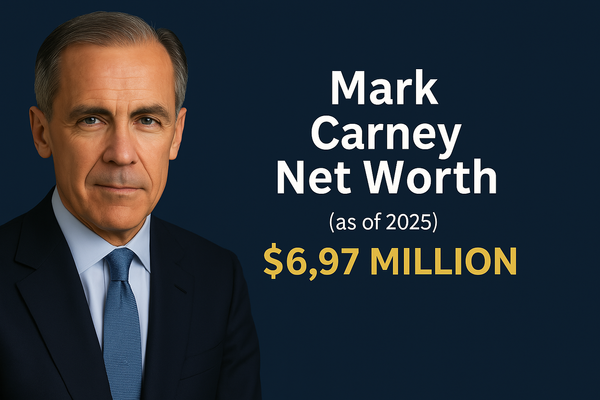Value(s) by Mark Carney Book Summary: What Banks Won't Tell You

Climate change might slash global GDP by up to 30% by 2100. Many banks still downplay this existential threat. Our mark carney book summary of "Value(s)" reveals these hidden truths of modern banking and more.
Carney's insider's view comes from his experience as a Goldman Sachs executive and central bank governor. The global financial crisis exposed dangerous flaws in market fundamentalism that led to excessive risk-taking. These practices continue today. The system has moved from a market economy to a market society where everything becomes a commodity - including our core values.
The book dives into Carney's seven vital values that create a thriving economy. It exposes the three lies of finance and shows why international cooperation is a vital part to solve our most pressing global challenges. This analysis helps you understand what banks won't tell you about money creation, climate risks, and our financial system's future.
Mark Carney's Banking Insider Perspective
"Value is built on values." — Mark Carney, Former Governor of the Bank of England and author of 'Value(s)'
Mark Carney stands out among financial experts. His remarkable experience from Wall Street to public service gives us a unique viewpoint of modern finance's inner workings.
From Goldman Sachs to central banking
Mark Carney was born in Fort Smith, Northwest Territories. He built a strong educational foundation with a bachelor's degree in economics from Harvard. He also earned both a master's and doctorate in economics from Oxford University. This academic background set him up for a 13-year career at Goldman Sachs. He worked in their Boston, London, New York, Tokyo, and Toronto offices.
Carney climbed the corporate ladder fast at Goldman. He took on senior roles such as co-head of sovereign risk and executive director for emerging debt capital markets. He ended up as managing director for investment banking. His achievements included helping South Africa access international bond markets after apartheid. He also managed parts of the 1998 Russian financial crisis.
A big change came in August 2003 when Carney moved to public service as deputy governor at the Bank of Canada. By February 2008, he became Governor of the Bank of Canada right when the global financial crisis hit. He handled this crisis so well that in 2013, he became the first non-British person to lead the Bank of England.
Why Carney wrote Value(s)
Carney's decades of high-level experience in private and public finance led him to write "Value(s): Building a Better World for All" in 2021. The book came from his front-row view during the financial crash. His quick actions at the Bank of Canada helped protect the country from the worst effects.
Carney saw worrying patterns in finance despite his success handling crises. His book shows how financial value grew more important than human values. During his December 2020 Reith Lecture for the BBC, Carney said clearly that "society had come to esteem financial value over human value and moved from market economies to market societies".
The book got mixed reviews. Some praised it for pushing once-unusual ideas into mainstream thinking. Others felt it should have said more about his Goldman Sachs years.
The three lies of finance revealed
Carney's book shines brightest when he tears apart what he calls "the three lies of finance." He first pointed out these falsities in a 2015 speech:
- "This Time Is Different" - The wrong belief that we've beaten economic cycles. This usually starts with success that creates blind faith in endless prosperity
- "Markets Always Clear" - The risky assumption that financial markets will balance themselves without help. This thinking caused big problems during the financial crisis
- "Markets Are Moral" - The mistaken idea that financial capital can take social capital's role in markets for granted
Carney attacks these "market fables" head-on. His detailed takedown of these myths is "worth the book alone". Notwithstanding that, his fixes focus on tweaking the current system instead of rebuilding it from scratch.
How Banks Separate Value from Values
"The market is humanity distilled." — Mark Carney, Former Governor of the Bank of England and author of 'Value(s)'
Carney's analysis reveals banking's false promises and explains a fundamental change in our economic reality. The financial system has changed how we measure worth. Money matters more than human wellbeing now.
The change from market economy to market society
In "Value(s)," Carney points out the difference between having a market economy and becoming a market society. This key difference, first highlighted by philosopher Michael Sandel, shows a crucial change. A market economy works as "a tool—a valuable and effective tool—for organizing productive activity." A market society represents "a way of life in which market values seep into every aspect of human endeavor".
We've switched from using markets as tools to letting market thinking control our lives. Sandel points out two major outcomes of this change. Money matters more than ever, which makes inequality worse. The nature of goods and services becomes corrupt when everything boils down to price and efficiency.
This change happened gradually. Historical research shows it took "a slow and protracted process, taking roughly one to two centuries." The "new market elites started to use their growing wealth to turn it into political" power.
When everything becomes a commodity
A market society turns everything into products for sale. These days, even priceless things come with price tags:
- Hunters can purchase the right to kill endangered black rhinos for CAD 348,340.05
- Corporations can buy permission to pollute for CAD 14.63 per metric ton of carbon dioxide
- U.S. immigration rights can be purchased for CAD 696,680.10
- Surrogate motherhood in India costs CAD 11,146.88 (one-third of U.S. prices)
Once this process starts, it speeds up. Financial markets helped technological breakthroughs and economic growth at first. They ended up becoming "a goal in itself" and "the easiest and most secure way to make accumulated capital profitable".
This trend goes beyond banking and revolutionizes whole sectors. Research shows that healthcare, education, housing, and criminal justice have become products. For-profit companies now run what used to be public services and non-profits.
The hidden cost of financial breakthroughs
Banks rarely talk about the substantial hidden costs of financial breakthroughs. Banks spend "more than 150 hours to vetting each new potential vendor." Most of this time goes to waste. This hidden expense reaches about CAD 139,336.02 for every CAD 1.39 billion in assets.
AI implementation brings unexpected costs despite its revolutionary promises. One mid-sized bank's data processing costs jumped 20% after adding AI. This added CAD 836,016.12 to annual expenses. The bank also lost CAD 696,680.10 on scattered pilot projects that failed.
Banks that wait too long to modernize face big losses too. Research shows that digitally advanced investment firms see impressive gains: 8.6% more revenue, 11.3% higher productivity, and 6.3% better market share. Slow movers risk losing CAD 110.08 million per billion dollars of revenue each year.
Carney's analysis reveals a basic truth behind these numbers: society and the financial system suffer when financial value loses touch with human values. We need to bring markets and morals back together to build an economy that lasts.
The Financial Crisis Revelations
Mark Carney's book "Value(s)" sheds light on some hard truths behind the 2008 global financial meltdown. His unique background as a Goldman Sachs veteran and crisis-fighting central banker helps us learn about what actually happened.
What really caused the 2008 crash
The financial crisis wasn't just bad luck. Several connected factors created a perfect storm. Carney shows how too much risk-taking thrived in what he calls a "favorable macroeconomic environment" with strong growth, low inflation, and low interest rates. These conditions pushed U.S. house prices up, which led both homeowners and investors to borrow recklessly.
Carney became Bank of Canada governor right as the crisis started in February 2008. He points out a bigger problem: financial breakthroughs moved faster than risk management could handle. Banks bundled thousands of mortgage loans into what became "complex and opaque" mortgage-backed securities (MBS). These kept getting high ratings despite their risks. Investors around the world bought these seemingly safe assets without knowing their true risks.
How banks misaligned incentives
His mark carney book summary reveals something crucial - how badly mismatched incentives corrupted the financial system:
- Bonus structures rewarded quick deals and short-term wins instead of lasting success
- Rating agencies gave subprime mortgages triple-A ratings just to collect fees
- Banks gladly used these triple-A ratings to back credit with minimal capital
These twisted incentives created what Carney calls a "principal-agent problem." Individual goals clashed with what was good for everyone. Banks and their staff chased yearly profits while ignoring how their actions would affect their own companies.
Why regulation failed
The regulatory system fell short for two main reasons. Carney clearly states that regulators "relied excessively on the ability of financial institutions to manage risk and to regulate themselves". Also, rules always seemed to play catch-up with quick financial changes.
The regulatory system had major blind spots. Regulators missed the system-wide risks tied to rapid credit growth and asset bubbles. Many central banks, including Carney's predecessors, "had not spotted the risks building in the financial sector" before disaster struck.
Without doubt, these findings in Carney's mark carney book explain why he later pushed for stricter financial rules through the Financial Stability Board, which he led from 2011 to 2018.
Central Banks' Hidden Powers
Mark Carney's revelatory mark carney book, "Value(s)," reveals central banks' extraordinary powers that remain hidden from public view. His insider knowledge shows financial mechanisms rarely discussed in mainstream conversations.
How money is actually created
Most people think central banks create our money. The truth might surprise you. Commercial banks generate about 80% of money in modern economies as electronic deposits through loans. Banks simply credit your account with new money when you borrow - they create it from nothing. This electronic money disappears when you repay these loans.
The Bank of England and Federal Reserve create just a small portion of the money supply. They buy securities through open market operations and add funds to commercial bank reserves. On top of that, they control short-term interest rates to influence commercial banks' money creation.
The truth about digital currencies
Central banks around the world are learning about digital currencies (CBDCs) that would work like cash in digital form. These currencies would differ from Bitcoin and other cryptocurrencies because governments would back them with stable values. CBDCs could make cross-border transactions cheaper, speed up payments, and help unbanked people access financial services.
CBDCs raise major concerns about privacy. They could destabilize banking if people moved large amounts from commercial bank accounts to central bank digital currency during financial stress—creating a digital bank run.
What central bankers don't advertise
Central bankers stay quiet about their emergency powers. They used unprecedented "unconventional measures" like quantitative easing during the 2008 crisis and COVID-19 pandemic. They can act as "market makers of last resort" and stabilize entire asset markets during crises.
Central banks' regulatory authority over financial institutions lets them ban individuals, impose multi-million dollar fines, and revoke bank authorizations. Carney points out in his mark carney book summary that these vast powers need "clear frameworks" to ensure accountability and effectiveness.
Climate Change: Banking's Biggest Secret
Mark Carney's book "Value(s)" sounds a stark alarm about the financial sector's dangerous lack of action on climate change. His analysis shows how banks talk about climate threats but dodge taking real steps to address them.
Why banks downplay climate risks
Four major Canadian banks and six U.S. financial giants have backed away from the UN-backed Net-Zero Banking Alliance—a program Carney himself once led. Banks keep talking about their climate commitment, yet they push back against including environmental risks in their business operations. Most global banks remain nowhere near ready for climate change's mounting risks. A survey of 50 large commercial banks revealed that 86% scored less than half the indicators for climate adaptation maturity. The banks' responses show they prefer to analyze risks rather than create actual adaptation solutions.
The coming carbon bubble
The financial system faces what Carney calls a "carbon bubble"—a risky overvaluation of fossil fuel assets. This bubble exists because fossil fuel companies' market valuations include carbon reserves they can't actually burn. The numbers paint a grim picture—stranded assets could reach CAD 5.57 trillion according to IPCC estimates. HSBC and BNP Paribas have already stepped back from directly financing new oil and gas fields, which suggests they see this crisis coming.
How financial institutions could drive real change
Banks wield enormous power to speed up climate transition, which needs annual investment of CAD 5.29 trillion. Sustainability-linked loans are a great way to get companies on board by offering lower interest rates when they hit specific environmental targets. Small changes in banking practices create big results—banks that welcome digital breakthroughs see 8.6% more revenue and 11.3% higher productivity. This suggests climate-aligned banking could boost performance similarly. Carney's book summary highlights how financial markets see sustainable investment as "a new horizon that opens up enormous opportunities ranging from transforming energy to reinventing protein".
Conclusion
Mark Carney's "Value(s)" reveals important truths about modern banking that we just need to understand. His perspective as both a Wall Street insider and central bank governor shows how the financial system has moved away from human values to focus purely on profits.
The shift from market economy to market society serves as a clear warning sign. Banks keep minimizing climate risks while holding onto dangerous market myths that put our economic future at risk. They resist meaningful climate action while a carbon bubble looms, which threatens stability worldwide.
A ray of hope still shines through. Carney's insights show that linking markets back to moral values creates a way forward. We should not accept everything becoming a commodity. Banks must work for society's broader interests. The financial sector can make powerful positive changes, especially when you have climate challenges to tackle. Our success depends on following Carney's guidance to rebuild a financial system based on human values instead of just profits.
FAQs
Q1. What is the main message of Mark Carney's book "Value(s)"? The book highlights how the financial system has prioritized monetary value over human values, leading to a shift from a market economy to a market society where everything becomes commodified.
Q2. What are the "three lies of finance" that Carney reveals in his book? Carney identifies three false beliefs in finance: "This Time Is Different," "Markets Always Clear," and "Markets Are Moral." These misconceptions have led to dangerous assumptions and practices in the financial world.
Q3. How do banks create money? Contrary to popular belief, commercial banks create about 80% of money in modern economies through loans, while central banks create only a small portion of the money supply.
Q4. What is the "carbon bubble" that Carney warns about? The carbon bubble refers to the dangerous overvaluation of fossil fuel assets, as many companies include currently unburnable carbon reserves in their market valuations, potentially leading to significant financial risks.
Q5. How can financial institutions drive positive change in addressing climate challenges? Banks can accelerate climate transition by offering sustainability-linked loans, embracing digital innovation, and recognizing sustainable investment as a significant opportunity for transformation in various sectors.

